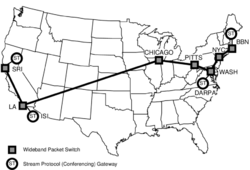Terrestrial Wideband Network
The Terrestrial Wideband Network was a DARPA-sponsored experimental network designed to support research in high-speed networking protocols and distributed multimedia applications. It was built and operated by BBN Technologies from May 1989 to about 1991; although originally planned to turn into the Defense Research Internet, it instead evolved into the Defense Simulation Internet.
The Terrestrial Wideband Network was a trans-continental network implemented via Wideband Packet Switches (based on BBN Butterfly parallel computers) connected by T1 circuits. It replaced the 3 megabit/second Satellite Wideband Network, which had been in operation for the previous 8 years. Because it was based on a single cross-country T1 trunk from the DARPA National Networking Testbed (NNT), the Terrestrial Wideband Network's topology was linear, i.e., a series of packet switches connected in a line by T1 trunks. Each T1 link ran at 1.544 megabits per second.
The Terrestrial Wideband Network provided standard Internet Protocol transport, but also multicast services and the experimental, connection-oriented Internet Stream Protocol (ST-II). Individual host computers could gain access to ST-II features via the Host Access Protocol (HAP), specified in RFC 907-A. Internally, the network was based on the Dual Bus Protocol (DBP), a descendant of the QPSX protocol proposed as the IEEE 802.6 Metropolitan Area Network (MAN) standard, enhanced to provide bandwidth reservations with access fairness, and to operate over long distances.
References
- "Terrestrial Wideband Network (DRI)", Katy Yoon, in The User's Directory of Computer Networks, ed. Tracy Laquey, Digital Press, pages 222-224, 1990.
- "The DARPA wideband network protocol", W. Edmond, K. Leib, C. Topolcic, ACM SIGCOMM '90 Proceedings of the ACM symposium on Communications architectures & protocols, pages 79-89.
- "Terrestrial Wideband Network", NSF Network Service Center (NNSC), Section 5.21, September 27, 1989.
- Distributed Interactive Simulation of Combat, Office of Technology Assessment, DIANE Publishing Company, 1996, page 27.
 |


